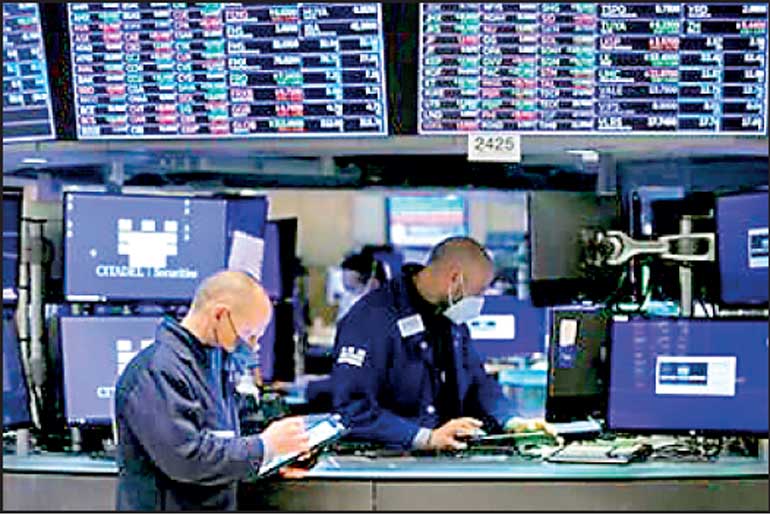Sunday Apr 20, 2025
Sunday Apr 20, 2025
Friday, 31 December 2021 00:00 - - {{hitsCtrl.values.hits}}
 LONDON (REUTERS): A seven-day rally in world stocks ran out of steam on Thursday as the spread of Omicron worldwide clouded bumper year-to-date gains, dented oil prices and boosted the dollar.
LONDON (REUTERS): A seven-day rally in world stocks ran out of steam on Thursday as the spread of Omicron worldwide clouded bumper year-to-date gains, dented oil prices and boosted the dollar.
Sentiment was supported, however, by signs that governments, despite coronavirus cases hitting record highs, are trying to limit the economic damage by relaxing rules on isolation rather than resorting to lockdowns.
MSCI’s global equity index has managed a 17% gain for the year, led by rises of 28% and 22% in the S&P 500 and Europe’s STOXX 600 respectively.
On Thursday, the index, which was treading water though European markets, climbed cautiously higher, and futures implied a modestly firmer open on Wall Street .
Despite concerns, the view seems to be that the highly transmissible Omicron COVID variant will be less lethal than feared, Berenberg Chief Economist Holger Schmieding said.
“Markets are back trading the rebound story, the recovery story for 2022,” Schmieding said, noting higher bond yields reflected expectations of economic recovery, and subsequently, a reduced pace of central bank support.
There was relief too in Asia where South Korea’s 5.1% industrial output surge may indicate some easing of supply chain problems. Chinese shares got a nearly 1% lift from Beijing, signalling lower interest rates in 2022, though they are set to end 2021 down 5.5%.
Japanese shares in their last trading day of the year, slipped 0.4% - a 4.9% annual gain but short of a three-decade top reached in September. Shares in semiconductor superpower Taiwan ended with a 24% annual jump.
However, persistent inflation and a resulting hawkish turn by the US Federal Reserve is a source of concern for markets, with investors starting to price in a first rate hike as early as March.
“We have these headwinds from the pandemic, we had headwinds from energy prices and sky-high inflation rates, but there is a fair chance that many of these factors, if not all of these factors, will ease in Q1 next year,” said SEB Strategist Jussi Hiljanen.
“But for a few months to come it will be very volatile and markets will be tested.”
Two-year US Treasury yields have shot up 55 basis points (bps) since September to stand at 0.75%, near the highest since March last year. However, reflecting expectations of a relatively short and shallow rate-rise cycle, 10-year yields have reacted far less, rising around 20 bps in this period. They are up four bps for the week but eased 1.6 bps on Thursday.
The rise in US borrowing costs has lifted German 10-year yields to a near two-month high of -0.171% before easing back to -0.199, up 15 bps since September.
The Fed outlook has combined with recent Omicron jitters to underpin the US dollar, which is set for a second month of gains. The greenback rose 0.4% against a basket of currencies to 96.2, bouncing off a three-week low touched on Wednesday when it was hit by the risk appetite revival.
The yen meanwhile has run into broad year-end selling over the past week, with the dollar reaching its highest since mid-November at 115.2 yen.
“The front end of the US rates market is pricing more rate hikes back into the curve now so FX may be a battle, once again, between optimism about the global recovery and expectations about the Fed,” said Societe Generale Strategist Kit Juckes.
However, oil prices slipped, hurt by demand growth concerns and news that China had cut its first batch of 2022 crude oil import quotas by 11% in a sign it would act against small inefficient refineries.
Brent crude futures fell 0.3% to $ 78.87 a barrel, slipping for the first time in four days.
However, Brent has climbed more than 50% this year, adding to the global inflation pulse. The impact showed up in Spanish data, showing that the annual inflation rate for December was the highest year-end reading since 1989.
Discover Kapruka, the leading online shopping platform in Sri Lanka, where you can conveniently send Gifts and Flowers to your loved ones for any event including Valentine ’s Day. Explore a wide range of popular Shopping Categories on Kapruka, including Toys, Groceries, Electronics, Birthday Cakes, Fruits, Chocolates, Flower Bouquets, Clothing, Watches, Lingerie, Gift Sets and Jewellery. Also if you’re interested in selling with Kapruka, Partner Central by Kapruka is the best solution to start with. Moreover, through Kapruka Global Shop, you can also enjoy the convenience of purchasing products from renowned platforms like Amazon and eBay and have them delivered to Sri Lanka.
Discover Kapruka, the leading online shopping platform in Sri Lanka, where you can conveniently send Gifts and Flowers to your loved ones for any event including Valentine ’s Day. Explore a wide range of popular Shopping Categories on Kapruka, including Toys, Groceries, Electronics, Birthday Cakes, Fruits, Chocolates, Flower Bouquets, Clothing, Watches, Lingerie, Gift Sets and Jewellery. Also if you’re interested in selling with Kapruka, Partner Central by Kapruka is the best solution to start with. Moreover, through Kapruka Global Shop, you can also enjoy the convenience of purchasing products from renowned platforms like Amazon and eBay and have them delivered to Sri Lanka.